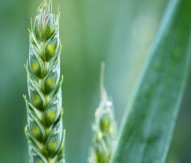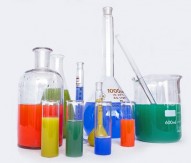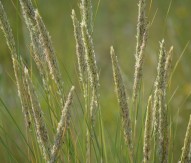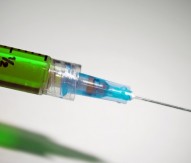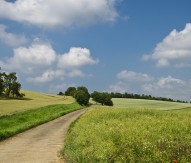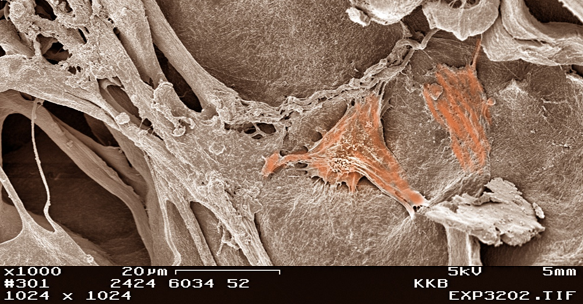
Profile: TOMorrow people
The University of Bern’s Tissue and Organ Mechanobiology Group is developing research that could transform the lives of millions
The Tissue and Organ Mechanobiology (TOM) Group conducts translational research in the intersection of tissue engineering, biology and applied clinical research. The group is embedded in the Institute for Surgical Technology and Biomechanics (ISTB) of the University of Bern.
The primary aim is to understand the cellular response onto biomechanical stimuli and how cellular communities are affected in situ using 3D tissue and organ culture models. Their research can be divided into two main foci: on the one hand the group investigates causes of low back pain due to intervertebral disc (IVD) degeneration; and on the other, the group focuses on the human knee where they aim to identify cell-based solutions for the non-healing or delayed ruptures of the anterior cruciate ligament (ACL).
The common focus of the TOM group, that is headed by Benjamin Gantenbein, is to develop in vitro organ culture models, which closely match the human situation and where regenerative therapy strategies, such as novel biomaterials and cells, can be tested in a most authentic in vitro set-up.
Special attention is given to the interface of cells and material surfaces. It is clear that with respect to repair or even regeneration of complex organs, the respective biological ‘niche’ of a cell has to be respected. In this respect, in recent years many new biomaterials and yet completely synthesised materials have been tested.
Networking
The group has a well-spun research network, which is distributed all over Switzerland, starting locally at the University of Bern with Willy Hofstettler’s Bone Biology Group, with Ms Dorbrila Nesic from the Osteoarticular Research Group and with Thomas Geiser’s Lung Regeneration Group. Clinicians are very important to provide the necessary stimulus and also financial support for the translational research: the spine surgeons, namely Lorin Benneker and Marius Keel of the orthopaedic department of the Insel University Hospital in Bern as well as Paul Heini from the Sonnenhof Clinic, Bern have been very supportive to the scientific team. The ACL research is also supported by the knee surgeons, namely Sandro Kohl of the Insel hospital and by Stefan Eggli from the Sonnenhof Clinic. The current network expands further from the AO Research Institute, EPFL Lausanne, the Institute for Biomechanics, ETH Zürich, University of Zürich, Empa St. Gallen, Swiss Paraplegic Centre in Nottwil to the University of Basel. Internationally, the group collaborates mainly with James Iatridis, Mount Sinai School of Medicine, New York, on the mechanobiology of intervertebral discs, with Daisuke Sakai on mesenchymal stem cell research and also with Barbara Chan, from Hong Kong University, on the application of a collagen type 2 annulus plug for the annulus fibrosus repair.
Teaching
The group is also active in the biomedical engineering programme and is co-lecturing the tissue engineering theoretical and fully organises the tissue engineering practical course. Furthermore, B Gantenbein teaches cell biology in the biological principles of human medicine, also in the biomedical engineering master’s course.
Intervertebral disc degeneration and low back pain
Recent years were focused on the development of a new loading device to cultivate IVD explants. Last year was a year of exploration of a new two degree of freedom bioreactor to test the importance of complex loading. The TOM Group advanced further into the understanding of complex forces such as compression and torsion onto IVD cells in situ in organ culture. Furthermore, the group explored non-viral gene therapy as an option for IVD regeneration using growth and differentiation factor 5 (GDF5) as a primary target for differentiating human mesenchymal stem cells towards IVD-like precursor cells.
The group developed a strong ex vivo model using bovine IVD organ culture. This model has been used to explore fast and reliable models for disc degeneration using non-clinical relevant enzymes such as papain or clinically relevant enzymes such as metallo-proteinases and high-temperature requirement A serine peptidase 1 (HTRA1).
Furthermore, the group is actively collaborating with well known international researchers, for instance via the AO Spine Research Network. Through this platform the group received an exchange fellow, Wai Hon Chooi from Barbara Chan’s group of the University of Hong Kong to work on a novel collagen annulus fibrosus (AF) ‘plug’ to repair the IVD. This exchange became possible by a competitive AOSpine International Scientific Research Network grant.
The project investigated the mechanobiological properties of the AF plug to seal the IVD. The AF is the outer fibrous part of an IVD, which has very poor self-healing capacities if ruptured and causes leakage of the inner more gel-like material, the nucleus pulposus (NP). This pathology is known as disc herniation. Thus, a ‘plug’ consisting of a photochemically cross-linked collagen to seal such a rupture has to fulfil a demanding task list, and has to withstand complex loading in the human spine.
To test these properties and to monitor leakage of the plug, the group applied electromagnetic beads mimicking disc or stem cells and used magnetic resonance imaging to monitor possible leakage prior to and after mechanical loading. Leakage and retention of beads could also be quantified as the beads were also fluorescent at the same time, and was determined by measuring the total fluorescence and the number of beads in the culture medium and inside the IVD, respectively.
The maximal force that the annulus plug could resist in the organ culture model was also investigated. The TOM Group has excellent network activities with the Insel University Hospital, from the orthopaedic department but also with the Institute for Diagnostic, Paediatric and Interventional Radiology, Inselspital.
‘Silk-spingeneering’
Silk is a very old and interesting biomaterial with high elastic properties and low allergenic potential if the sericin component has been removed. Here, the TOM Group started to investigate into new growth-factor-enriched silk, which is produced from genetically transducted silk worms (Bombyx mori). In this project the human growth factor of interest is covalently linked to the silk, which is also produced by the GMP certified silk worm breed.
The new biomaterial will be tested in vitro on disc and mesenchymal stem cells but also in our 3D organ culture model and the complex loading bioreactor. Furthermore, the group investigated in a collaboration with the Empa St. Gallen, Laboratory of Physiology, the electro-spinning of liquid silk into scaffolds.
Future work will be to develop ‘smart’ scaffolds of silk and embedded growth factors to push mesenchymal stem cells towards an intervertebral disc-like phenotype. Here, with the help of electro-spinning new silk, nano-fibre scaffolds are being produced which are tested for intervertebral disc repair. This project is financed by the Gebert-Rüf Foundation Project ‘Silk-o-Disc’ Project no. GRS-X028/13 and is on-going. The aim is to develop new silk scaffolds to ‘re-inflate’ the ‘flat-tyre’ of a degenerated disc.
The application of collagen matrixes and mesenchymal stem cells
Anterior cruciate ligament (ACL) injuries are very common; in Switzerland the incidence of ACL ruptures is estimated at 32 per 100,000 in the general population and in the sports community this rate more than doubles. The current gold standard for anterior cruciate ligament repair is reconstruction using an autograft. However, this approach has shown some limitations.
A new method has been heralded by the knee team at the Bern University Hospital (Inselspital) and the Sonnenhof Clinic called Dynamic Intraligamentary Stabilisation (DIS), which keeps ACL remnants in place in order to promote biological healing and makes use of a dynamic screw system. Here, cell-based approaches using collagen patches or application of platelet derived plasma (PRP) and platelet rich fibrin (PRF) are of interest and will be investigated in the near future to evaluate the ‘boost’ healing potential for the non-healing and retracting ACLs. The aim of this study will be to investigate the application of collagen patches in combination with DIS to support regeneration of the ACL. Here, the TOM Group investigates towards the development of a new bioreactor system to maintain whole ACLs under culture, and to maintain the tissue’s integrity such as nutrition supply and to maintain a high cell viability over time. As the ACL is a linear oriented tissue, the tissue can serve as a much simpler model for tissue repair than the more complex 3D organ cultures of the IVD. ACLs are also tested in vitro to infer the mechanical properties.
Core competences
The TOM Group has acquired core competences in the following areas:
- 3D organ culture models;
- In vitro stimulation of tissue/organ explants under controlled mechanical load;
- Two degree of freedom loading device to culture intervertebral discs;
- Testing of biomaterials in a most realistic set up with living tissue under load;
- Cytocompatibility testing of biomaterials using cell lines and primary cells (e.g. LIVE/DEAD stain);
- Human patient-derived cell culture;
- Relative gene expression; and
- Immunohistology.
Acknowledgements
The group received financial support from the Swiss National Science Foundation (SNF project #310030_153411), the Gebert-Rüf foundation, the CABMM and from AO Spine International.
Selected publications
Bucher C, Gazdhar A, Benneker LM, Geiser T, Gantenbein-Ritter B (2013) Nonviral Gene Delivery of Growth and Differentiation Factor 5 to Human Mesenchymal Stem Cells Injected into a 3D Bovine Intervertebral Disc Organ Culture System. Stem Cells Int 2013: 326828. doi: 10.1155/2013/326828
Chan SC, Bürki A, Bonél HM, Benneker LM, Gantenbein-Ritter B (2013) Papain-induced in vitro disc degeneration model for the study of injectable nucleus pulposus therapy. Spine J 13(3):273-283 doi: 10.1016/j.spinee.2012.12.007
Chan SCW, Walser J, Käppeli P, Shamsollahi MJ, Ferguson SJ, Gantenbein-Ritter B (2013) Region Specific Response of Intervertebral Disc Cells to Complex Dynamic Loading: An Organ Culture Study Using a Dynamic Torsion-Compression Bioreactor. PLoS ONE 8(8):e72489. doi: 10.1371/journal.pone.0072489
Furtwängler T, Chan SC, Bahrenberg G, Richards PJ, Gantenbein-Ritter B (2013) Assessment of the Matrix Degenerative Effects of MMP-3, ADAMTS-4 and HTRA1 injected into a bovine Intervertebral Disc Organ Culture Model. Spine 38(22):E1377-E1387 doi: 10.1097/BRS.0b013e31829ffde8
Malonzo C, Chan SCW, Kabiri A, Eglin D, Grad S, Bonél M, Benneker M, Gantenbein-Ritter B (2013) A papain-induced disc degeneration model for the assessment of thermo-reversible hydrogel-cells therapeutic approach. J Tissue Eng Regen Med: doi: 10.1002/term.1667
Recent peer-reviewed presentations at international meetings by the group
Chan SCW, Calandriello E, Wuertz K, Keel M, Benneker LM, Gantenbein-Ritter B. (2014) Co-Culture of Notochordal Cells with Intervertebral Disc Cells. Proceedings of TERMIS-EU Meeting, 10-13 June. Genova, Italy.
Chan SCW, Calandriello E, Wuertz K, Keel M, Benneker LM, Gantenbein-Ritter B. (2014) Co-culture of Notochordal Cells with Nucleus pulposus and Annulus fibrosus cells under normoxia and hypoxia. World Forum for Spine Research, 15-17 May. Xi’An, China.
Chan SCW, Walser J, Ferguson B, Gantenbein-Ritter B. (2014) Extended duration of torsional loading reduced the survival of the NP cells of the intervertebral disc. World Forum for Spine Research, 15-17 May. Xi’An, China.
Chan SCW, Walser J, Ferguson B, Gantenbein-Ritter B. (2014) Intervertebral disc cell response to torsion as a function of duration and magnitude. Proceedings of the ECM XV Conference – Cartilage & Disc: Repair and Regeneration, 16-18 June. Davos, Switzerland.
Chan SCW, Walser J, Ferguson SJ, Gantenbein-Ritter B. (2014) Extended Duration of torsional Loading reduced the survival of Nucleus Pulposus Cells of the Intervertebral Disc in a bovine Organ Culture Model. 7th World Congress of Biomechanics, 6-11 July. Boston, MA.
Chooi WH, Chan SCW, Gantenbein-Ritter B, Chan B. (2014) Expression of HSP72 and HSF1 in nucleus pulposus in response to compressive loading. Proceedings of the ECM XV Conference – Cartilage & Disc: Repair and Regeneration, 16-18 June. Davos, Switzerland.
Chooi WH, Chan SCW, Gantenbein-Ritter B, Chan B. (2014) Loading Induced Stress Response in the Intervertebral Disc. World Forum for Spine Research, 15-17 May. Xi’An, China.
Chooi WH, Chan SCW, Gantenbein-Ritter B, Chan BP. (2014) Cellular Stress Response of Intervertebral Cells to Compressive Loading. Proceedings of TERMIS-EU Meeting, 10-13 June. Genova, Italy.
Gantenbein-Ritter B. (2014) Mechano Biology of the Intervertebral Disk – Where do we stand? 7th World Congress of Biomechanics, 6-11 July. Boston, MA.
Horovitz R, Ahmad S, Chan SCW, Kohl S, Gantenbein-Ritter B. (2014) Suitability of Common Collagen Scaffolds for Anterior Cruciate Ligament Repair. Proceedings of TERMIS-EU Meeting, 10-13 June. Genova, Italy.
Schmocker AM, Khoushabi A, Gantenbein-Ritter B, Chan S, Bonél HM, Bourban P-E, Månson JA, Schizas C, Pioletti D, Moser C. (2014) Minimally invasive photopolymerization in intervertebral disc tissue cavities. SPIE BiOS.
Studer T, Fortunato G, Gadhari N, Frauchiger D, Rossi R, Gantenbein-Ritter B. (2014) Engineering niches for intervertebral disc cells using random and aligned silk nano-fibres. Proceedings of the Swiss Society of Biomaterials and Regenerative Medicine, 7-8 May. Basel.
Studer T, Fortunato G, Gadhari N, Frauchiger D, Rossi R, Gantenbein-Ritter B. (2014) Tailoring silk based nano fibres for human intervertebral disc repair. Proceedings of the ECM XV Conference – Cartilage & Disc: Repair and Regeneration, 16-18 June. Davos.

Prof Dr Brigitte von Rechenberg
Chair
Competence Centre for Applied Biology & Molecular Medicine
tel: +41 446 358 410
www.cabmm.uzh.ch/index.html
PD Dr Benjamin Gantenbein-Ritter
Tissue and Organ Mechano Biology, Institute for Surgical Technology and Biomechanics, University of Bern
